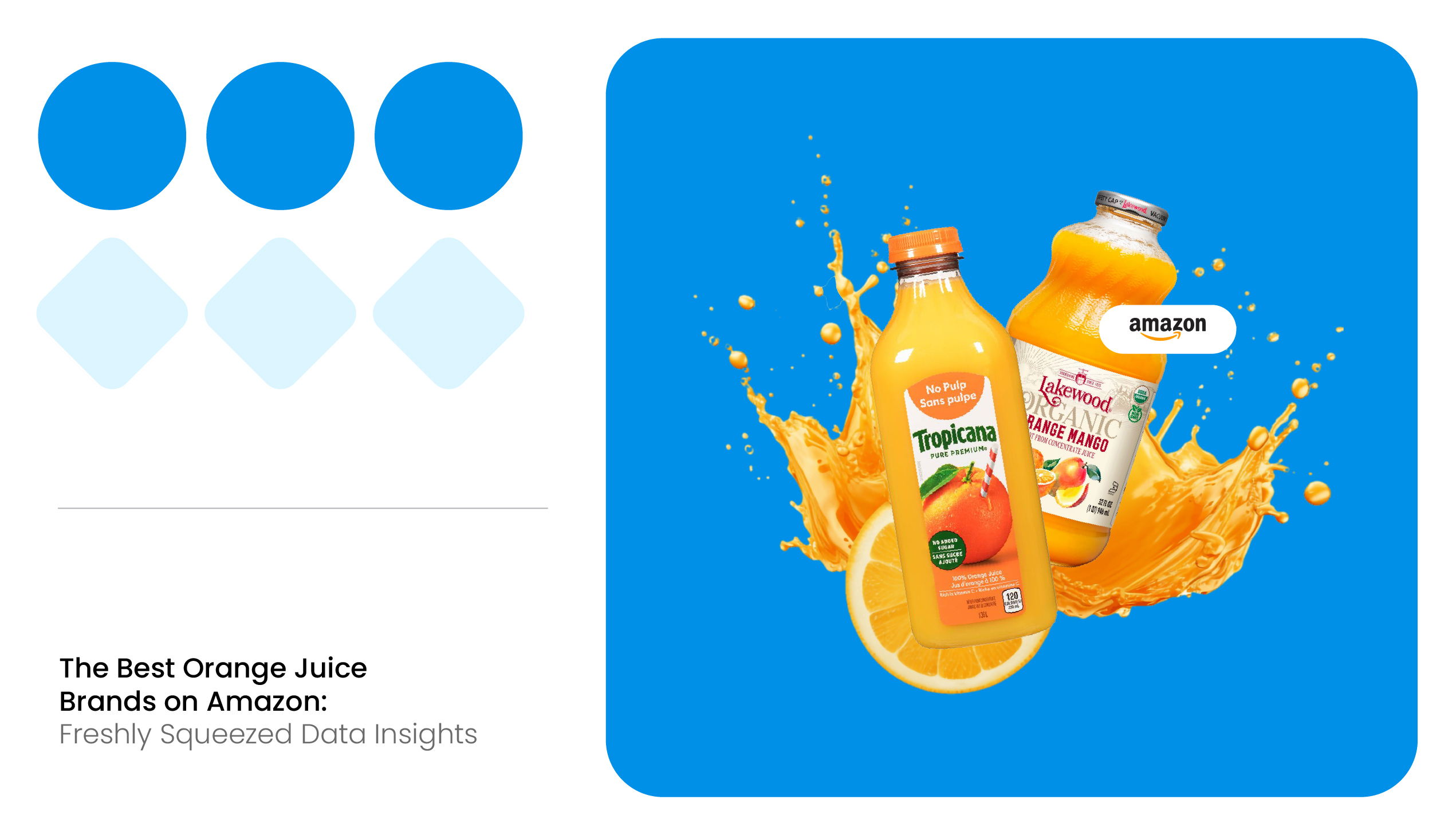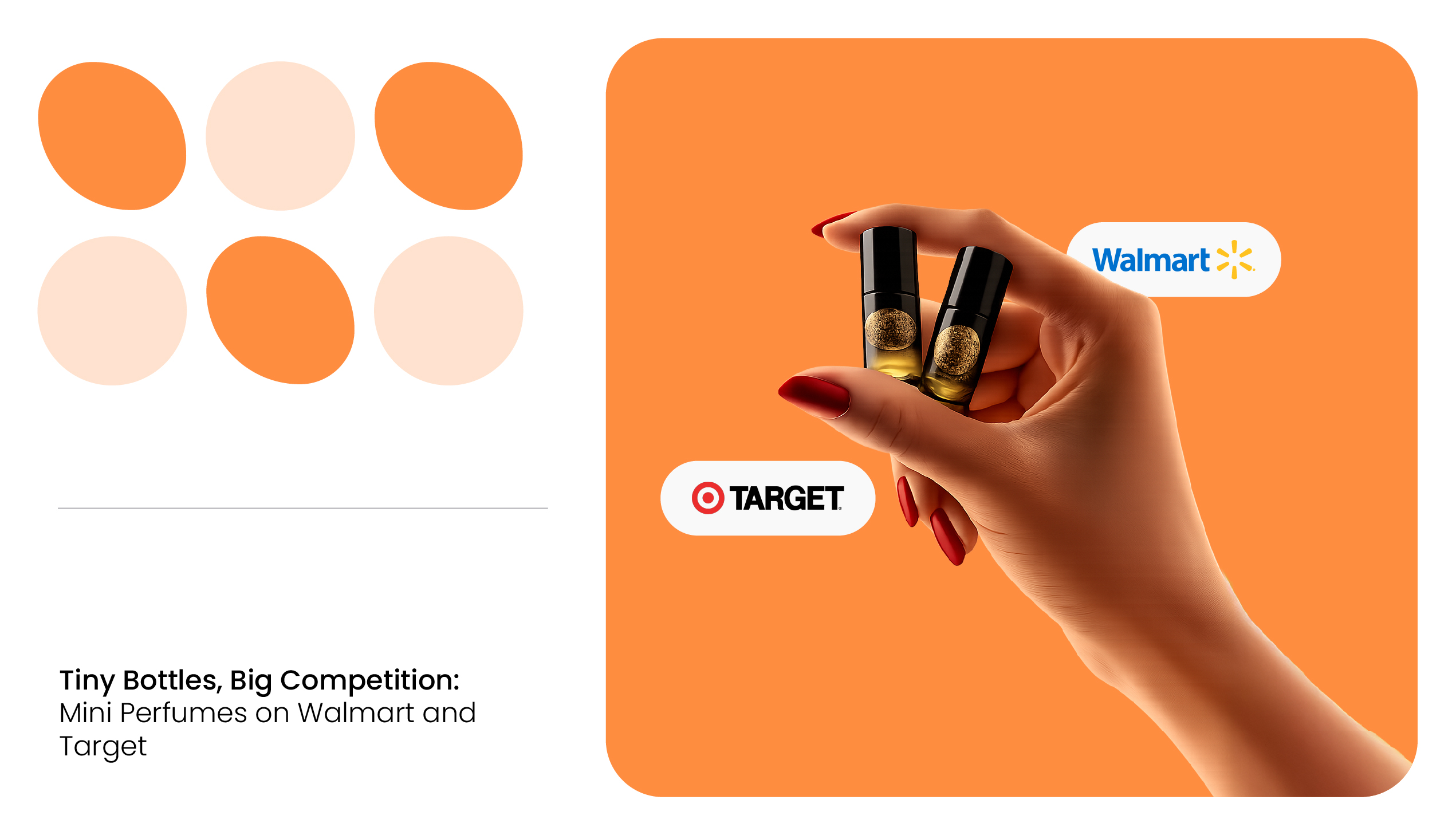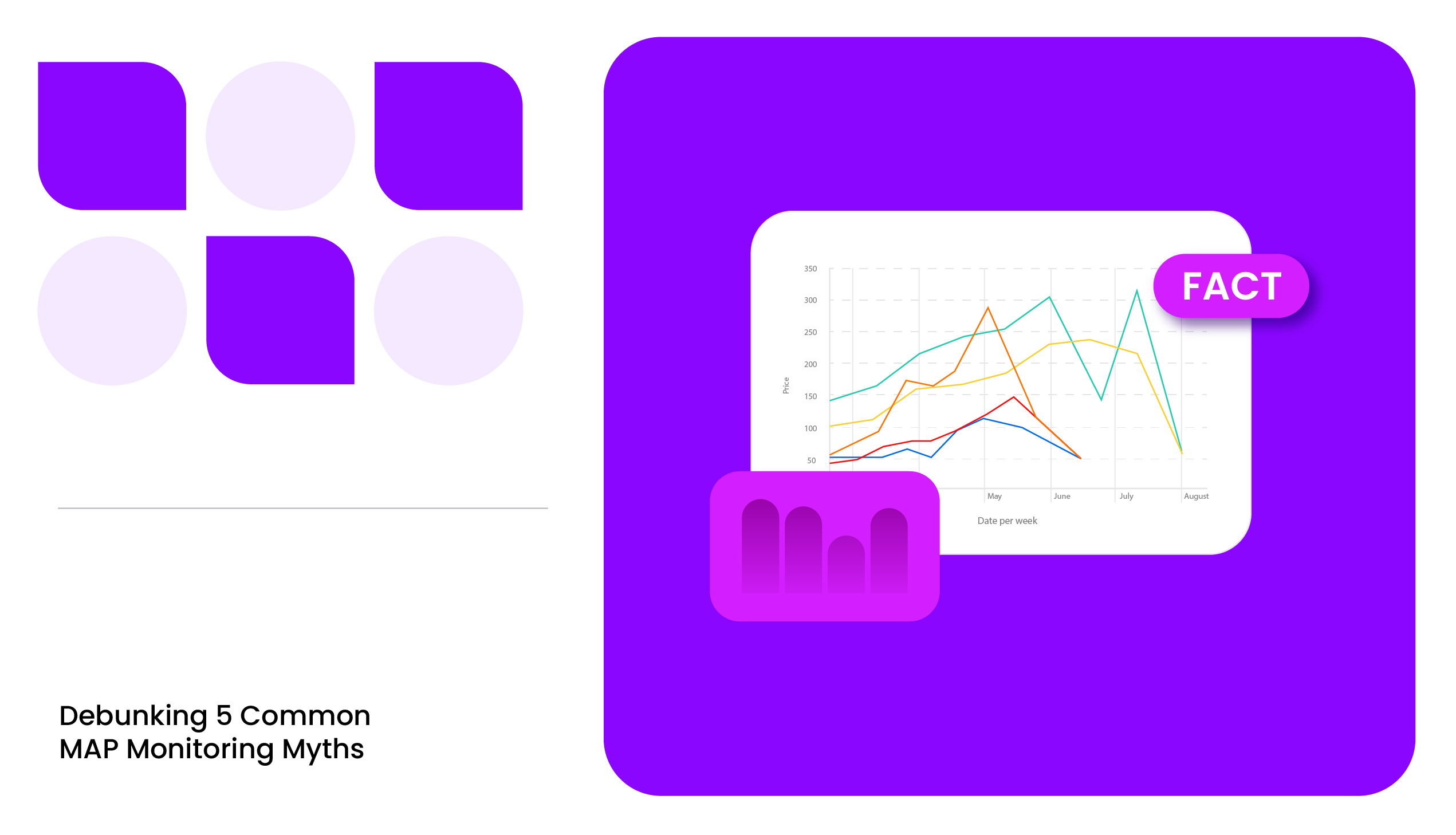About This Report
This report is a detailed look into the orange juice category on Amazon, informed by our analysis of 1,475 products as of June 2025. Layered with global industry context, from the broader orange juice market to evolving consumer behaviors and beverage trends, this report will explore how orange juice brands compete across pricing, features, reviews, and promotions. From the major players to the emerging challengers, we’ll explore what works and why in the Amazon orange juice category.
Highlights
- Tropicana dominates the orange juice category on Amazon with 259 SKUs and over 1.27 million reviews, followed closely by Ocean Spray and Langers.
- The top-reviewed product is the TRUE ORANGE Water Enhancer (500-pack), with 23,571 reviews.
- Juicy Juice leads on discounts, averaging 19.19% off, outperforming most peers on the promotional front.
- 5-star orange juice products cost just $13.17 on average, whereas unrated ones carry a premium at $41.86, signaling that trust plays a critical role in price acceptance.
- Health-forward claims like “No High Fructose” and “No Added Sugar” drive the highest engagement, garnering 1.29M and 1.18M reviews, respectively.
How Does The Global OJ Market Currently Taste Like?
Let’s step back and zoom out before we zoom in.
Globally, the orange juice market is holding and growing steadily. The Business Research Company estimates it will go upto $7.27 billion in 2029 at 6.9% CAGR (from $5.24 billion in 2024).
What’s fueling this? Research consistently points to premium and organic positioning, clean-label transparency, functional fortification (like immune support), and new formats like single-serve or portable packs.
In the US, demand is shaped by a paradox we see clearly on Amazon: consumers are reducing sugar and scrutinizing labels even as they still turn to juice for wellness and enjoyment. People want healthier drinks, but they still want them to taste great; a “permission to enjoy” factor that’s strong in juices.
The Amazon orange juice category reflects these shifts, with health claims and functional benefits now becoming crucial elements in the buying decision.
For instance, Tropicana and Ocean Spray, which traditionally focused on flavor and family-oriented messaging, have increasingly highlighted health benefits in their marketing to align with the functional health wave.
The demand in the US is also influenced by price sensitivity (especially after recent inflation spikes) and supply pressures. Florida’s output is at historic lows due to citrus greening disease, weather damage, and reduced acreage. Imports from Brazil and Mexico now make up the majority of the US supply.
This adds another layer of complexity to Amazon’s pricing and promotions; some brands are caught in the price elasticity loop as they try to maintain margins while dealing with supply uncertainties.
Who Are The Major Players In The Orange Juice Category on Amazon?
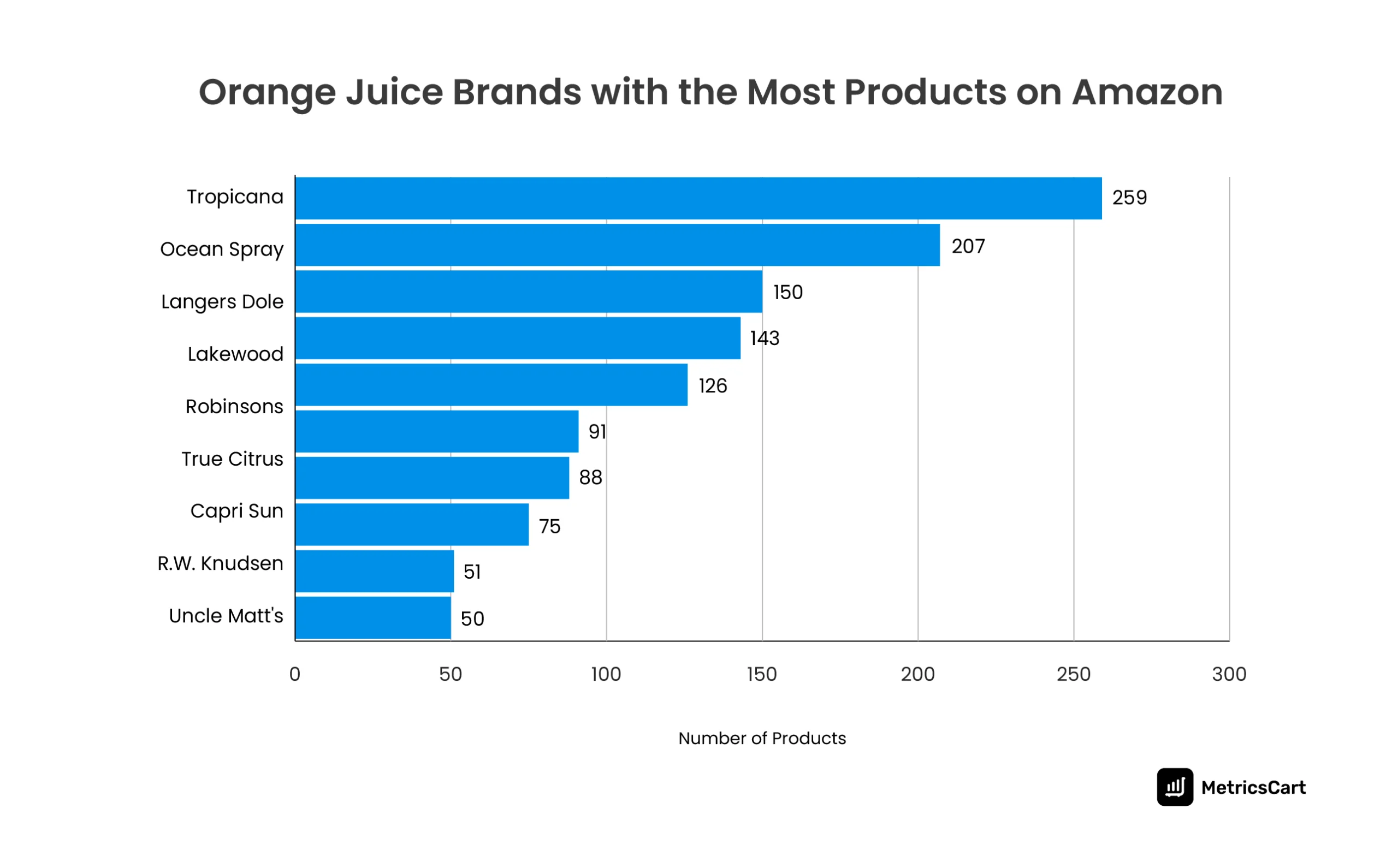
When it comes to dominance among orange juice brands on Amazon, it’s no surprise that Tropicana leads the pack, with 259 products listed. Ocean Spray and Dole follow with 207 and 143 products, respectively, and Langers rounds out the top contenders with 150 products.
These companies have established brand recognition, a wide range of products, and a deep understanding of the consumer market. Their ability to diversify their offerings across different formats and consumer needs gives them a massive advantage in visibility.
The sheer volume of SKUs means more chances to show up in relevant customer searches. It supports the idea that assortment breadth matters when it comes to Amazon’s search algorithm.
However, the question isn’t just about the number of listings; brands, such as True Citrus and Capri Sun, are successfully capitalizing on specific consumer needs by offering more convenient formats and clean ingredients, delivering a clear value proposition.
By narrowing its focus and delivering exactly what that audience wants (a flavorful, low-sugar, and convenient product), True Citrus has captured a significant portion of Amazon’s orange juice market share. This shows that focus and targeted offerings can outperform category giants.
Which are the Most Reviewed Orange Juice Brands on Amazon?
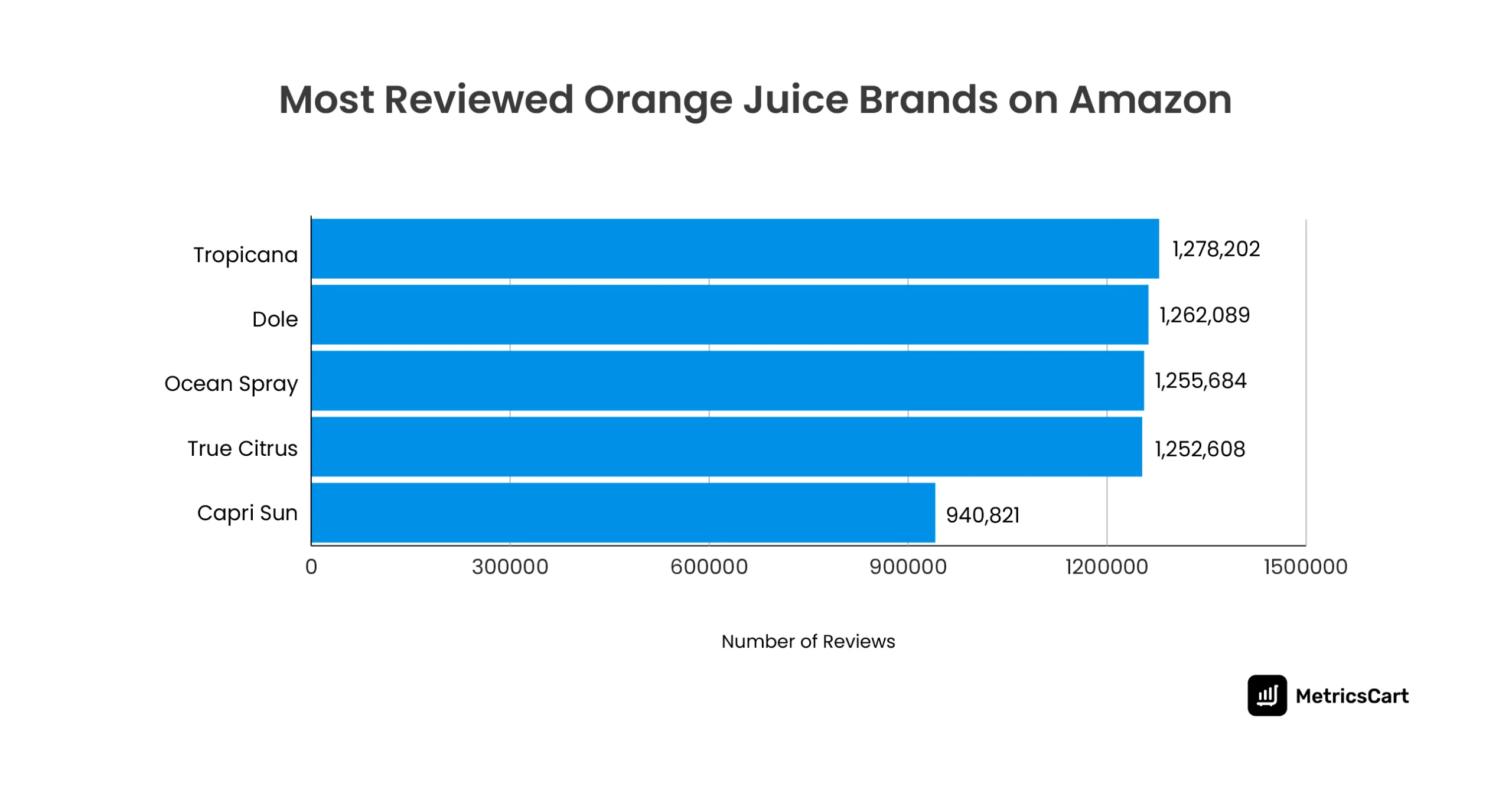
Let’s break down the numbers here: Tropicana, Dole, and Ocean Spray lead the pack in terms of reviews. The reason? These brands are household names, and consumers trust them. They’ve spent years building brand recognition, which translates to more people searching for their products, more people reviewing their purchases, and ultimately more sales.
But True Citrus makes an interesting case. With just 88 SKUs, True Citrus has captured nearly the same number of reviews as the big brands, demonstrating that a focused product range with health-forward messaging can make a significant impact.
It’s a reminder that brand strength doesn’t always come from equity; it comes from creating meaningful connections with consumers who are looking for exactly what you offer.
Which Orange Juice Products Are Getting the Most Reviews on Amazon?
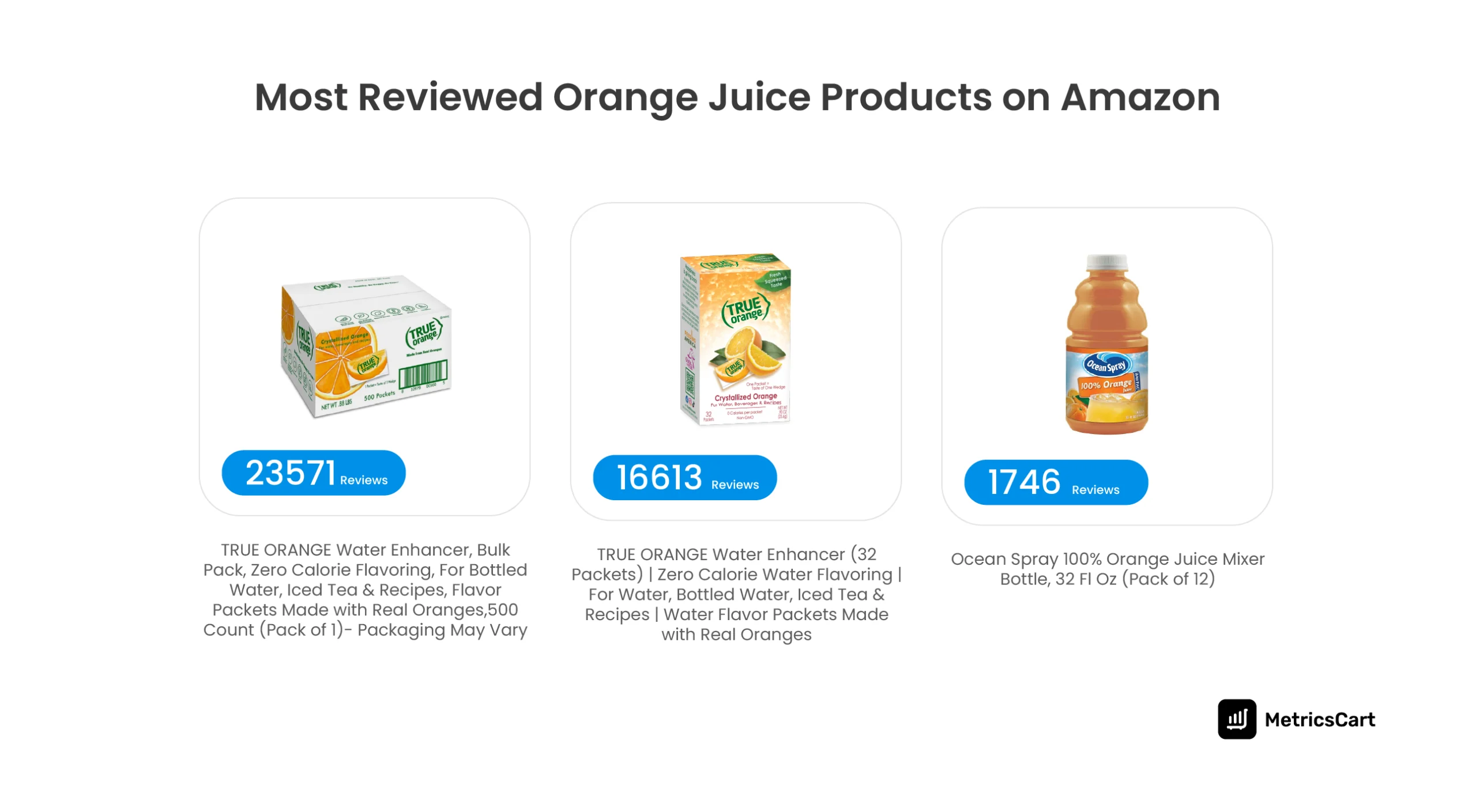
When it comes to sheer engagement, the TRUE ORANGE Water Enhancer (500-count) is at the top of the list, followed by its 32-pack variant. These products represent a shift from traditional bottled juices to functional, convenient options, demonstrating that small, healthier solutions such as enhancers for water are resonating with consumers. This ties back to the growing demand for on-the-go formats that can be easily incorporated into daily routines.
This shift reflects broader trends in consumer behavior; people want healthier choices that are easy to integrate into their busy lives.
READ MORE | Reviews are key for higher conversion rates and better sales! Learn How To Get Reviews on Amazon: The Essential Guide
What Are Consumers Looking For When Buying Orange Juice on Amazon?
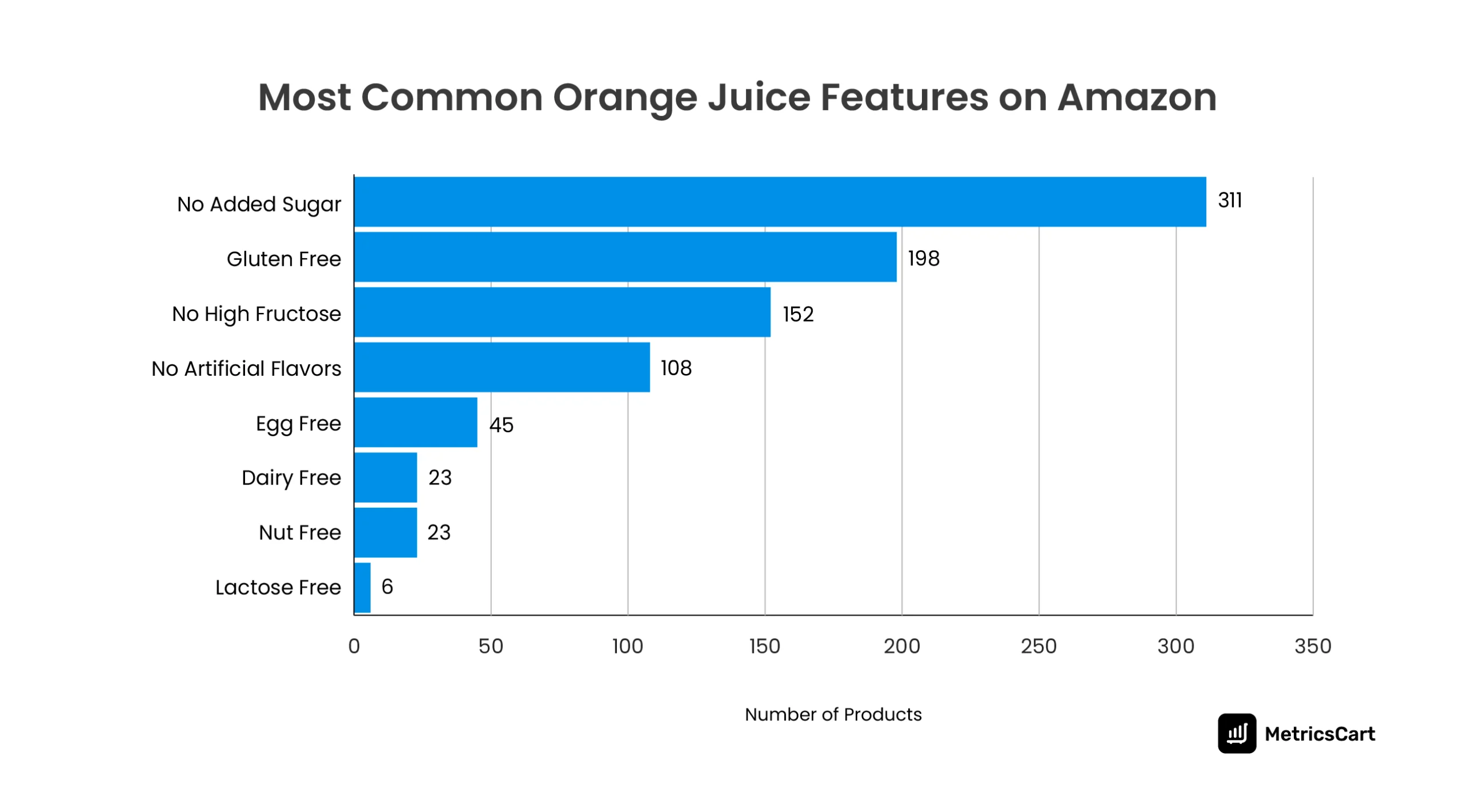
The orange juice category on Amazon shows a distinct shift towards health-conscious and ingredient-focused products. The most common features that consumers seek are “No Added Sugar” (311 products), “Gluten-Free” (198 products), and “No High Fructose” (152 products), signaling a growing demand for cleaner, healthier options.
Products with these features are receiving millions of reviews, indicating that they resonate with a significant portion of the Amazon shopping base.
Health-conscious shoppers are increasingly avoiding sugar-laden beverages in favor of drinks that align with their wellness goals. This trend is supported by market reports, showing that consumers, especially Gen Z and millennials, are moving toward functional beverages that provide health benefits beyond basic hydration.
Similarly, “Gluten-Free” and “No High Fructose” feature prominently in the search for clean, natural ingredients, aligning with growing concerns about artificial additives and high-fructose corn syrup. This is a clear reflection of how consumers are more mindful of the ingredients in the products they consume, pushing brands to offer transparency and clarity in their ingredient lists.
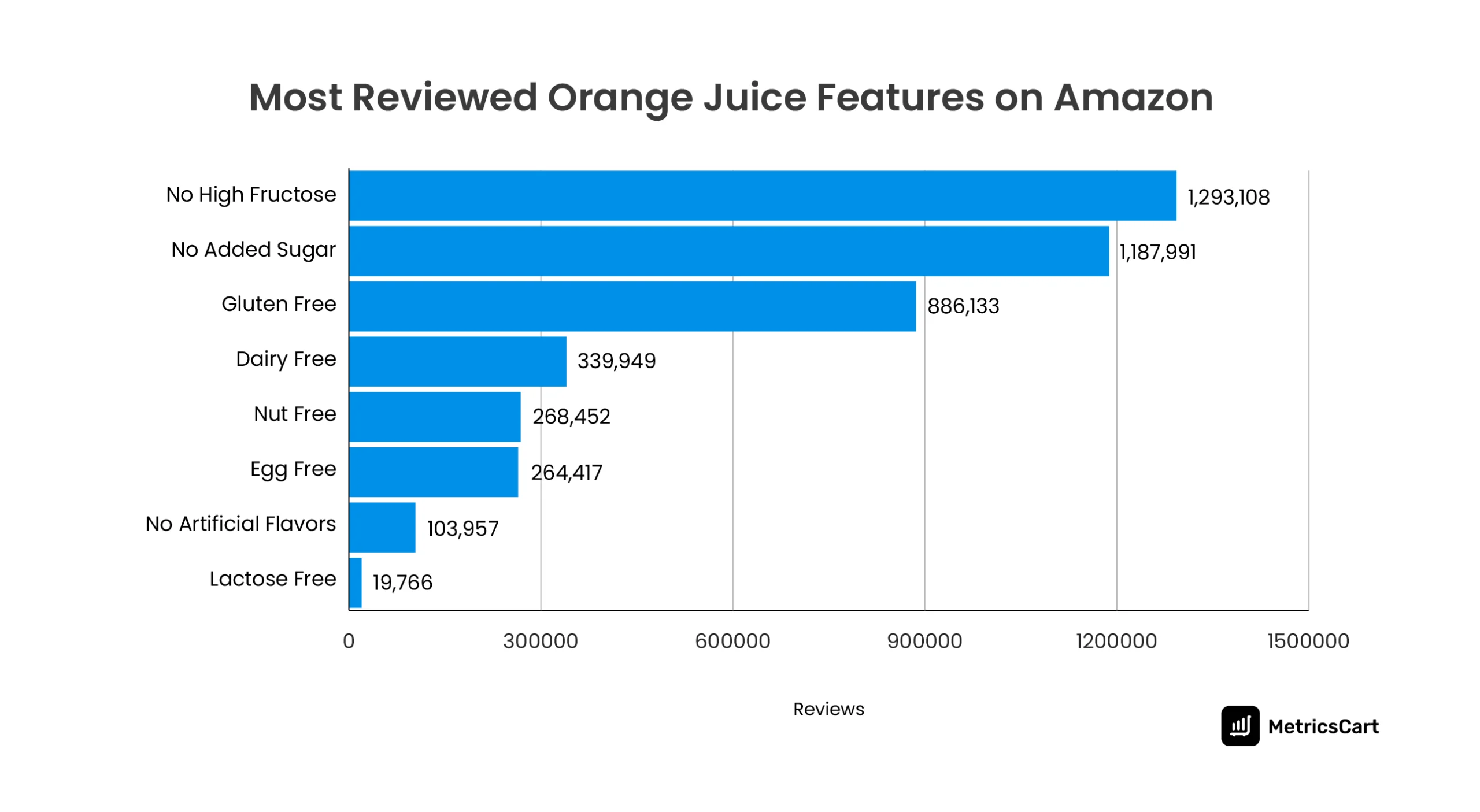
“No Added Sugar” and “No High Fructose” are the most reviewed features, confirming that consumers are not just health-conscious, but also actively seeking products that align with their wellness objectives.
The high number of reviews highlights the consumer trust in brands that prioritize natural, clean ingredients and functional benefits. As shoppers increasingly focus on reducing added sugars and avoiding artificial additives, those brands that clearly communicate these attributes will resonate most.
Brands that ensure their PDP (Product Detail Page) content and packaging effectively highlight these key features win. Clear, concise messaging about the absence of artificial ingredients, along with detailed health claims (like low sugar or gluten-free), can significantly influence consumer trust and conversion rates.
Among orange juice brands on Amazon, it’s not enough to just be another juice brand; you need to clearly communicate how your product benefits the consumer’s lifestyle.
READ MORE | Functional beverages are already taking up the headlines! Check out Olipop vs. Poppi: Data Insights Into A Fizzy Face-Off.
Most Expensive vs Most Affordable Orange Juice Brands on Amazon
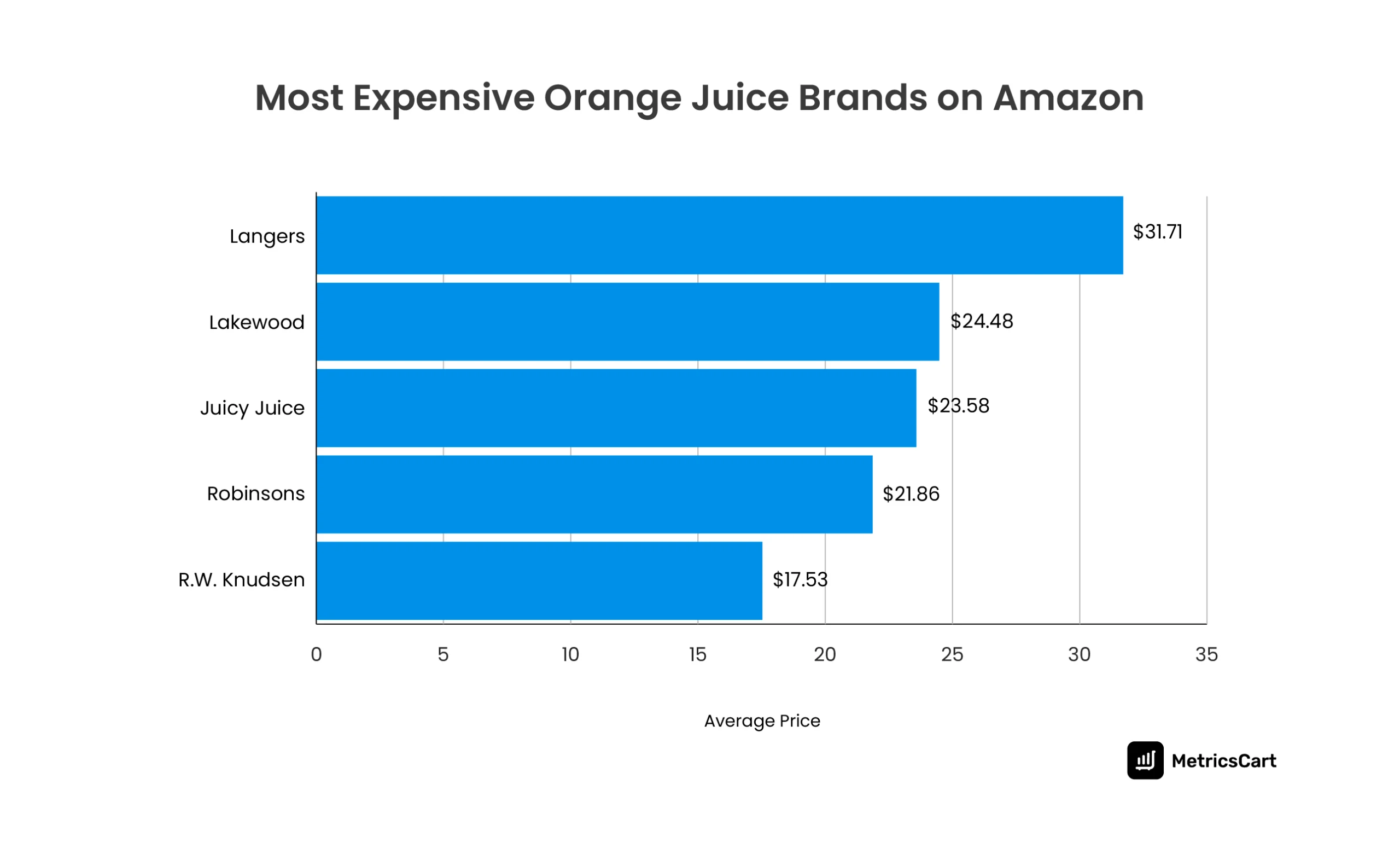
Langers leads the charge at $31.71, far outpacing its competitors. Lakewood, Juicy Juice, and Robinsons also appear in this premium price range, with prices hovering between $21.86 and $24.48. These higher price points are indicative of premium positioning in the market.
Brands like Langers and Lakewood typically market their juices as organic or high-quality, which appeals to consumers seeking better ingredients and more health-focused products. The premium pricing also suggests a strong focus on product differentiation, with these brands possibly offering higher quality, better packaging, or unique flavors.
Price psychology plays a significant role in how these brands are perceived. A higher price tag often signals quality and exclusivity, attracting consumers who are willing to pay a bit more for premium ingredients or health benefits such as organic certification or added nutrients like vitamin C or fiber.
This perception works well on Amazon, where consumers can compare products side by side and often gravitate toward higher-priced options if they align with health-conscious values or provide functionality beyond basic hydration.
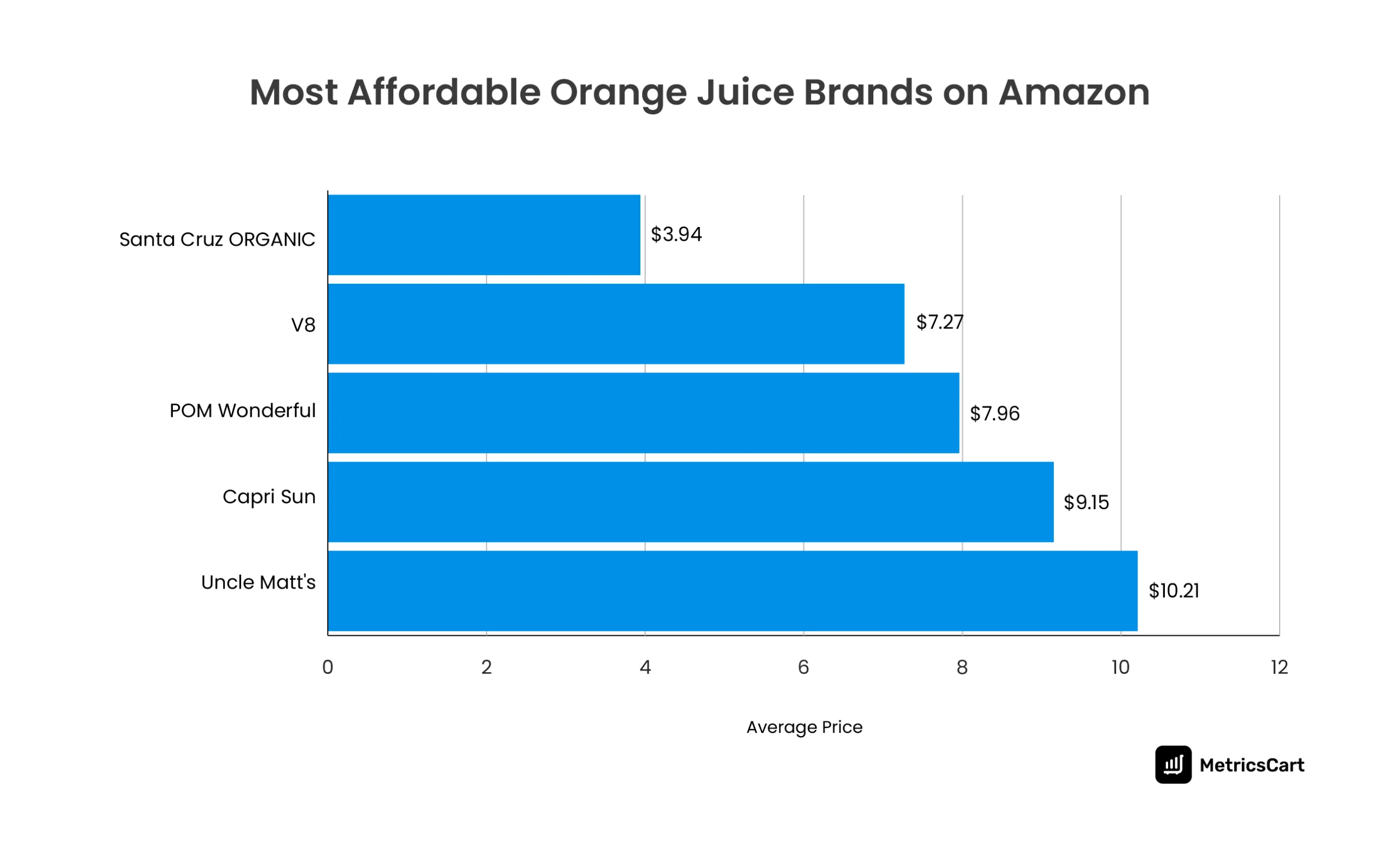
On the other hand, the most affordable brands like Santa Cruz Organic ($3.94) and V8 ($7.27) target a different segment of the market: those looking for affordable, quality juice. Despite being more budget-friendly, these brands do not compromise on product integrity; for instance, Santa Cruz Organic is able to maintain organic certification at a competitive price. The $3.94 price tag for Santa Cruz Organic makes it incredibly appealing for consumers who want to enjoy organic products without breaking the bank.
Meanwhile, V8 and POM Wonderful offer juices priced at $7.27 and $7.96, respectively, positioning themselves as affordable yet functional options, especially given V8’s emphasis on providing vegetable juice blends that go beyond traditional fruit-based juices.
These affordable prices also have an effect on conversion rates. Brands that fall in the mid-to-low price range are more likely to appeal to budget-conscious consumers. However, even in this segment, consumers still care about ingredient transparency and functional benefits (e.g., low sugar, no added preservatives, vitamin-rich).
Offering good value without sacrificing quality is critical for success in the affordable category. In fact, some consumers are willing to pay a little more for added value, such as health benefits (vitamins, immunity boost), which brands like V8 have capitalized on.
In a competitive category like this, your pricing strategy can make or break your business. With MetricsCart’s price intelligence tool, curate the right price plan backed by accurate data insights and competitor price monitoring.
How Are Organic vs Non-Organic Orange Juices Priced on Amazon?
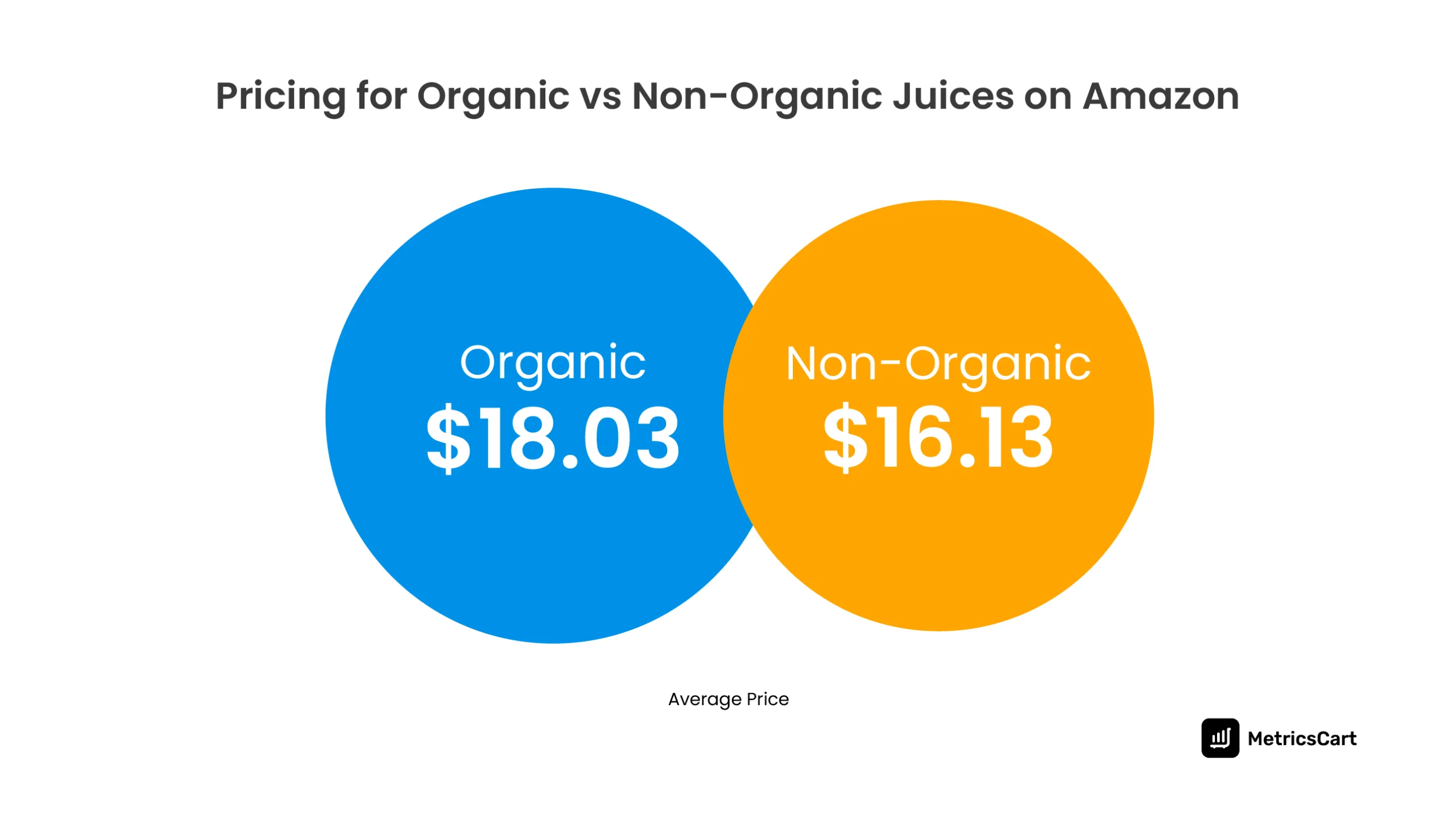
Looking at the price comparison between organic and non-organic orange juice on Amazon, there’s a slight price premium for organic juice; $18.03 for organic orange juices versus $16.13 for non-organic ones. That $1.90 difference may not seem huge, but it highlights an important trend: consumers are becoming more willing to pay a bit more for organic products, especially when it aligns with their health or sustainability values.
What’s interesting here is that the organic price gap is narrowing. This means that organic orange juices are becoming more accessible and competitive, allowing a larger pool of consumers to opt for them. The health-focused demographic is willing to pay a bit more for that organic assurance, but now it’s easier to justify spending that extra $1.90.
Which Orange Juice Brands Offer the Best Discounts on Amazon?

Discounts in the Amazon orange juice category follow a strategic pattern. Juicy Juice offers the highest discount at 19.19%, followed by Langers at 5.66%.
Smaller or niche brands often use limited discounts to attract trial, whereas large legacy brands maintain consistent pricing, relying on brand trust and visibility.
The correlation between discounting and review engagement is nuanced. Similarly, sponsored products, priced slightly higher on average ($17.89 vs $16.24 for non-sponsored), receive fewer reviews, indicating that organic visibility and brand reputation continue to outweigh aggressive pricing in influencing purchase behavior.
Brands must balance discounting with perceived value; too aggressive discounts may erode brand prestige, whereas modest discounts can encourage adoption without undermining trust.
How to Win the Orange Juice Category on Amazon in 2025?
The Amazon orange juice category is no longer just about volume; it’s about understanding evolving consumer expectations around convenience, wellness, and trust. Products that innovate in format, flavor, and functionality, like single-serve enhancers, clearly outperform traditional options, highlighting the importance of differentiation in capturing attention and repeat purchases.
Transparency and authenticity are critical. Shoppers increasingly seek features like “No Added Sugar,” “Gluten-Free,” and organic certifications, and products with strong reviews dominate both visibility and sales. Brands that invest in quality, clear labeling, and verified consumer feedback build lasting trust.
Pricing must balance accessibility and brand positioning. While a premium segment exists, the bulk of volume comes from mid-tier offerings. Strategic pricing, informed by competitor monitoring and product differentiation, ensures both competitiveness and perceived value.
Promotional pricing strategies are most effective when coupled with organic credibility. Over-reliance on discounts can dilute brand perception, while thoughtful campaigns aligned with seasonal demand or new launches drive sustainable growth.
Ultimately, winning brands treat Amazon as a dynamic ecosystem where assortment, packaging, marketing, pricing, and consumer insights intersect. By innovating, maintaining transparency, pricing strategically, and leveraging both reviews and promotions intelligently, brands can capture market share, foster loyalty, and thrive in the Amazon orange juice category.
Conclusion
There’s one key takeaway that this report unveils: category success depends on how brands are seen, perceived, and chosen by consumers, not just on the number of SKUs they list.
To stay ahead in competitive categories like the orange juice category on Amazon, your brand needs more than just intuitions and “this might work” strategies. You need actionable insights and data-driven solutions, and that’s where MetricsCart’s suite of digital shelf analytics tools comes in.
Track performance in real-time, optimize your listings, uncover opportunities hidden in your reviews and ratings, and stay ahead of competitors. MetricsCart helps you make data-driven decisions that drive visibility, sales, and growth. Don’t just compete; lead your category with actionable intelligence. Book a free walkthrough today to see it in action.
Disclaimer: MetricsCart is the exclusive owner of data used in the Digital Shelf Insights reports. Any kind of third-party usage entails due credit to the source material.
Ready To Take Control of Your Brand Performance? Strategize With Our Digital Shelf Solutions!

